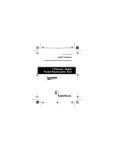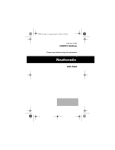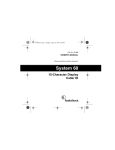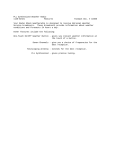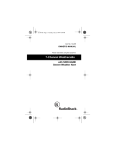Download Radio Shack 240 Owner`s manual
Transcript
12-240.fm Page 1 Tuesday, July 6, 1999 3:08 PM Cat. No. 12-240 OWNER’S MANUAL Please read before using this equipment. Weatheradio with Alert 12-240.fm Page 2 Tuesday, July 6, 1999 3:08 PM FEATURES Your Radio Shack Weatheradio with Alert is designed to receive National Weather Service broadcasts. These broadcasts provide information about weather conditions and forecasts 24 hours a day. Your radio receives these transmissions from up to 50 miles away. Its features include: Alert Mode — monitors weather broadcasts and sounds an alert siren in emergency weather situations. Optional Siren Lock — sets the siren to sound until you turn it off. Siren Test Button — lets you check the alert siren to make sure the alert circuit is operating. Two Antennas — give you the option of using the power cord or the telescoping antenna for the best reception. Battery Backup — automatically switches to internal battery power if AC power is interrupted. Three Channels — let you choose the frequency that provides the best reception. Crystal-Controlled Tuning — provides accurate tuning. © 1996 Tandy Corporation. All Rights Reserved. Radio Shack and Weatheradio are registered trademarks used by Tandy Corporation. 2 12-240.fm Page 3 Tuesday, July 6, 1999 3:08 PM Warning: To prevent fire or shock hazard, do not expose this product to rain or moisture. CAUTION RISK OF ELECTRIC SHOCK. DO NOT OPEN. ! CAUTION: TO REDUCE THE RISK OF ELECTRIC SHOCK, DO NOT REMOVE COVER OR BACK. NO USER-SERVICEABLE PARTS INSIDE. REFER SERVICING TO QUALIFIED PERSONNEL. This symbol is intended to alert you to the presence of uninsulated dangerous voltage within the product’s enclosure that might be of sufficient magnitude to constitute a risk of electric shock. Do not open the product’s case. ! This symbol is intended to inform you that important operating and maintenance instructions are included in the literature accompanying this product. The graphical symbols with supplemental markings are located on the bottom of the unit. 3 12-240.fm Page 4 Tuesday, July 6, 1999 3:08 PM CONTENTS Power Sources ............................................................ 5 Connecting AC Power ............................................ 5 Installing a Backup Battery ..................................... 5 Operation ..................................................................... 6 Receiving Weather Broadcasts .............................. 6 Using the Alert Mode .............................................. 7 Testing Alert Operation ........................................... 8 Testing the Alert Circuit .................................... 9 Testing Alert Reception .................................. 10 Care and Maintenance .............................................. 11 FCC Statement ..................................................... 12 Specifications ............................................................ 13 4 12-240.fm Page 5 Tuesday, July 6, 1999 3:08 PM POWER SOURCES CONNECTING AC POWER Plug the Weatheradio’s power cord into a standard AC outlet. Caution: To prevent electric shock, the plug’s blades are polarized and fit only one way. If the plug will not fit easily, turn it over and try again. Do not force it. INSTALLING A BACKUP BATTERY The radio automatically switches to battery power if AC power fails. Follow these steps to install a 9-volt battery (not supplied), such as RadioShack Cat. No. 23-553. 1. Remove the battery compartment cover by pressing the tab in the direction of the arrow and lifting up the cover. 2. Snap the battery connector onto the battery contacts. 3. Place the battery in the compartment and replace the compartment cover. 5 12-240.fm Page 6 Tuesday, July 6, 1999 3:08 PM OPERATION RECEIVING WEATHER BROADCASTS Follow these steps to receive National Weather Service (NWS) broadcasts. 1. To turn on the radio, turn VOLUME to the right until it clicks. The alert indicator lights. When you turn on the radio, it is set to the alert mode. 2. Press WEATHER to set the radio to receive weather broadcasts. The alert indicator turns off. 3. Set ANTENNA to LINE. Note: If the signal is broken or noisy, set ANTENNA to ROD . Then unsnap the telescoping antenna and extend it to its full length. If reception is still not clear, try locating the radio near an outside wall or window. 4. Set CHANNEL to the frequency that provides the best reception. 6 12-240.fm Page 7 Tuesday, July 6, 1999 3:08 PM 5. Adjust VOLUME to a comfortable listening level. 6. To turn off the radio, turn VOLUME to the left until it clicks. USING THE ALERT MODE You can set the Weatheradio to alert you when the National Weather Service broadcasts an emergency signal, without having to listen to continuous weather updates. Follow these steps to set the radio to the alert mode. 1. To turn on the radio, turn VOLUME to the right until it clicks. The radio is in the alert mode and the alert indicator lights. Then set VOLUME to its center position. Note: If the radio is set to receive weather broadcasts, simply press ALERT to set the radio to the alert mode. The alert indicator lights and the receiver is silent. 2. Set ALERT LOCK as follows: ON — The siren sounds until you press WEATHER to silence it. OFF — The siren sounds only during the 10-second alert signal broadcast. 7 12-240.fm Page 8 Tuesday, July 6, 1999 3:08 PM Note: We suggest you use the OFF setting when you will be away from the radio so the siren does not disturb others if it sounds. When you return, the radio’s alert indicator flashes to let you know that the radio received an alert signal broadcast. 3. When the radio receives an alert signal and sounds the alert siren, press WEATHER. The siren stops (if it is still sounding), the alert indicator stops flashing, and you hear the current weather broadcast. 4. To turn off the radio, turn VOLUME to the left until it clicks. Caution: If severe weather threatens, do not wait for an alert; turn on your radio and monitor the latest weather information. TESTING ALERT OPERATION For your Weatheradio to be effective, you must place the radio where you can hear its alert tone (see “Testing the Alert Circuit”) and where it can receive an emergency alert broadcast (see “Testing Alert Reception”). Once you determine a location that meets these two conditions, leave the radio there for the best protection. 8 12-240.fm Page 9 Tuesday, July 6, 1999 3:08 PM Testing the Alert Circuit The TEST button lets you hear the alert siren the Weatheradio produces, but does not guarantee your radio will receive an emergency alert broadcast (see “Testing Alert Reception”). Follow these steps to sound the alert siren. 1. Turn on the Weatheradio. 2. Press ALERT. The alert indicator lights. 3. Press and hold TEST. The siren sounds. If ALERT LOCK is set to ON , press WEATHER to stop the siren. If ALERT LOCK is set to OFF, the siren sounds only while you hold down TEST. 9 12-240.fm Page 10 Tuesday, July 6, 1999 3:08 PM Testing Alert Reception The fact that you get clear voice reception or that the siren sounds when you press TEST does not guarantee that an emergency alert broadcast will trigger your Weatheradio’s alert siren. Also, if you are in a fringe area, your radio might be triggered by an alert broadcast in one area, but not be triggered if you place it somewhere else (even close by). To verify actual reception, your radio must receive a test or emergency alert broadcast. The National Weather Service (NWS) broadcasts a test alert every week on Wednesday between 11 AM and 12 noon. To find out the specific test schedule in your area, contact your local National Oceanic and Atmospheric Administration (NOAA) or National Weather Service office. These offices are usually listed in the telephone directory under “US Government, Department of Commerce.” To verify that your Weatheradio receives the test alert properly, press ALERT before the time when the test alert is broadcast in your local area. If the test alert broadcast does not trigger your radio’s alert siren, you are either out of range of the broadcast, the power cord is disconnected, or your radio’s batteries are weak. Note: If you use your Weatheradio when you travel, be sure to test it at its new location. 10 12-240.fm Page 11 Tuesday, July 6, 1999 3:08 PM CARE AND MAINTENANCE Your Weatheradio is an example of superior design and craftsmanship. The following suggestions will help you care for your radio so you can enjoy it for years. Keep the radio dry. If it gets wet, wipe it dry immediately. Liquids might contain minerals that can corrode the electronic circuits. Use and store the radio only in normal temperature environments. Temperature extremes can shorten the life of electronic devices and distort or melt plastic parts. Keep the radio away from dust and dirt, which can cause premature wear of parts. Handle the radio gently and carefully. Dropping it can damage circuit boards and cases and can cause the radio to work improperly. Use only fresh batteries of the required size and type. Old batteries can leak chemicals that damage your radio’s electronic parts. 11 12-240.fm Page 12 Tuesday, July 6, 1999 3:08 PM CLEANER Wipe the Weatheradio with a damp cloth occasionally to keep it looking new. Do not use harsh chemicals, cleaning solvents, or strong detergents to clean the radio. Modifying or tampering with the Weatheradio’s internal components can cause a malfunction and might invalidate your radio’s warranty and void your FCC authorization to operate it. If your radio is not performing as it should, take it to your local Radio Shack store for assistance. FCC STATEMENT Your Weatheradio might cause TV or radio interference even when it is operating properly. To determine whether your radio is causing the interference, turn it off. If the interference goes away, your radio is causing it. Try to eliminate the interference by: • Moving your radio away from the receiver • Contacting your local Radio Shack store for help If you cannot eliminate the interference, the FCC requires that you stop using the radio. 12 12-240.fm Page 13 Tuesday, July 6, 1999 3:08 PM SPECIFICATIONS Frequency Coverage ................Channel A: 162.400 MHz Channel B: 162.475 MHz Channel C: 162.550 MHz Power Output...................................... Maximum 440 mW Power Supply...................... 120 Volts, 60 Hz, 5 watts AC Battery Backup Power ....9-Volt Battery (Cat. No. 23-553) Antenna .............................Line Cord or Telescoping Rod Dimensions (HWD) ....................13/4 × 61/16 × 41/8 Inches (45 × 153 × 104 mm) Weight................................................................... 15.5 oz (439 g) Specifications are typical; individual unit might vary. Specifications are subject to change and improvement without notice. 13 12-240.fm Page 14 Tuesday, July 6, 1999 3:08 PM NOTES 14 12-240.fm Page 15 Tuesday, July 6, 1999 3:08 PM 15 12-240.fm Page 16 Tuesday, July 6, 1999 3:08 PM RADIO SHACK LIMITED WARRANTY This product is warranted against defects for 90 days from date of purchase from Radio Shack company-owned stores and authorized Radio Shack franchisees and dealers. Within this period, we will repair it without charge for parts and labor. Simply bring your Radio Shack sales slip as proof of purchase date to any Radio Shack store. Warranty does not cover transportation costs. Nor does it cover a product subjected to misuse or accidental damage. EXCEPT AS PROVIDED HEREIN, RADIO SHACK MAKES NO EXPRESS WARRANTIES AND ANY IMPLIED WARRANTIES ARE LIMITED IN DURATION TO THE DURATION OF THE WRITTEN LIMITED WARRANTIES CONTAINED HEREIN. Some states do not permit limitation or exclusion of implied warranties; therefore, the aforesaid limitation(s) or exclusion(s) may not apply to the purchaser. This warranty gives you specific legal rights and you may also have other rights which vary from state to state. We Service What We Sell 9/94 RADIO SHACK A Division of Tandy Corporation Fort Worth, Texas 76102 4A6 Printed in China
















